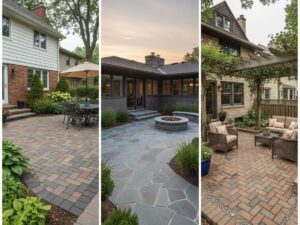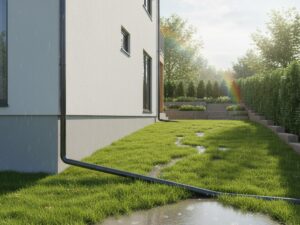If your yard is on a slope, you’ve likely battled issues such as soil erosion, flooding after rain, or uneven ground that limits how you use your space. Left unchecked, these challenges can damage your landscape and even threaten your home’s foundation. Retaining walls offer a proven solution, providing both stability and long-term protection. Engineered with safety in mind, retaining walls are built using smart design principles that prevent costly landscaping problems and create more usable space for patios, walkways, or gardens.
Let’s explore what retaining walls are, the engineering principles behind them, and why they are essential for outdoor living spaces.
What Are Retaining Walls and Their Common Uses?
A retaining wall is a specially engineered structure designed to resist the sideways pressure of soil or water. Its primary function is to hold back the earth that would otherwise move or erode due to gravity, rainfall, or changes in terrain. Unlike ordinary garden walls built purely for decoration, retaining walls are structural systems that combine strength and durability.
Materials Commonly Used in Retaining Wall Design
Retaining walls can be constructed from a variety of materials, including:
- Segmental concrete blocks: Interlocking units popular for residential landscaping.
- Natural stone: Offering strength with timeless aesthetics.
- Reinforced concrete: Commonly used for taller or load-bearing walls.
- Treated timber: Cost-effective for smaller residential projects.
For insights into retaining wall designs, you can explore the types of retaining walls that suit different property requirements.
Common Applications of Retaining Walls
Below are some of the most common applications and installation areas for retaining walls.
Residential Backyards and Gardens
One of the most popular applications for retaining walls is in residential landscapes. Homeowners often use them to manage sloped yards, creating level terraces for planting, outdoor seating, or play areas. Retaining walls can also be built around garden beds, providing elevation for ornamental plants and improving drainage.
When paired with pathways or patios, retaining walls bring order, texture, and a finished look to your outdoor design. Partnering with paver patio contractors ensures the walls and hardscape are seamlessly integrated, durable, and built to last.
Driveways and Parking Areas
Retaining walls are frequently installed alongside driveways and parking areas, especially on properties with uneven terrain. They prevent soil from sliding onto paved surfaces and protect vehicles from unstable ground.
Pool Decks and Outdoor Living Spaces
Pools often require precise grading, and retaining walls help secure the soil around pool decks or adjoining patios. By holding the surrounding ground in place, they maintain the structural integrity of both the pool and its surrounding hardscape features. Retaining walls also provide opportunities for raised seating areas, planters, or decorative finishes that enhance the pool’s overall design.
Near Water Features or Shorelines
Properties located near lakes, rivers, or ponds often face erosion issues due to fluctuating water levels. Retaining walls act as barriers, stabilizing the shoreline and preventing soil from washing away. In residential designs, they can also frame water features such as fountains, koi ponds, or backyard streams, creating a polished and structured appearance.
Around Outdoor Structures
Retaining walls are commonly used to protect the ground around outdoor structures such as sheds, pergolas, or firepits. They ensure that structures remain level and secure over time.
When Do You Need Retaining Walls for Your Outdoor Oasis?
Erosion Control
One of the most common situations where retaining walls are needed is on sloped properties. Steep gradients can be difficult to use and even dangerous, especially if the soil is prone to sliding after heavy rainfall. Retaining walls hold soil in place, reduce the risk of landslides and washouts during heavy rain, which is particularly important in areas prone to water runoff or flooding.
Grade Management and Terracing
On properties with steep terrain, retaining walls allow homeowners to level out the land and create terraces. This process increases the usability of the yard and provides opportunities for features such as patios, gardens, or walkways that would otherwise be impossible to build.
Soil Instability
Unstable soils such as clay, loose sand, or fill material exert additional lateral pressure on landscapes. Over time, this instability can damage nearby structures or make the terrain unsafe. A well-engineered retaining wall provides the reinforcement needed to counter these pressures.
Water Drainage Problems
Poor drainage often leads to water pooling, soil washout, and weakened foundations. Retaining walls with integrated drainage systems, such as gravel backfill, perforated drainpipes, and weep holes, redirect excess water away from your property, protecting both the landscape and nearby structures.
Foundation and Structural Protection
If your home, garage, or pool is built close to a slope, shifting soil can compromise the stability of those structures. Retaining walls create a protective barrier, keeping the surrounding soil secure and reducing the risk of costly foundation repairs. Plus, following essential retaining wall longevity tips ensures they remain strong, functional, and durable for years to come.
Designing Outdoor Living Features
If you’re planning to add features like an outdoor kitchen, hot tub, or water feature on uneven terrain, retaining walls provide the level foundation required. Without them, these amenities may sit unevenly or suffer from drainage issues, leading to long-term maintenance problems.
If you already have a retaining wall, it’s helpful to know the common retaining wall issues & fixes so you can address potential problems early.
The Engineering Process of Retaining Walls for Safety and Longevity
The strength and durability of a retaining wall depend on the application of proven engineering methods. Retaining wall engineering is a multi-step process that takes into account soil mechanics, structural loading, and drainage design to ensure the wall performs as intended for decades.
Site Analysis
Before construction begins, the site is carefully evaluated to identify potential risks. The retaining wall contractor assesses soil type, since clay soils hold water and exert more pressure than sandy soils. They also study slope gradients, load-bearing capacity, and surface water patterns to determine the most effective retaining wall design.
Structural Design Development
Based on site analysis, engineers apply retaining wall engineering principles to develop the wall’s structural design. This includes calculating lateral earth pressures, sliding resistance, and overturning moments. The wall type – whether gravity, cantilevered, anchored, or segmental block is selected according to the site’s load and stability requirements. Material specifications are also finalized at this stage to ensure both strength and aesthetics.
Drainage Integration
Water is one of the leading causes of retaining wall failure, so effective drainage is a non-negotiable component of design. Engineers incorporate weep holes, perforated drainage pipes, and granular backfill to relieve hydrostatic pressure. Geotextiles may also be used to separate soil layers while allowing water to pass through.
Reinforcement Techniques
For taller or load-bearing walls, reinforcements such as geogrid layers, steel bars, or tiebacks are installed. These additions improve stability and extend the wall’s service life, particularly in challenging soil conditions. Reinforced concrete footings are often used as a foundation to distribute loads evenly and prevent settling.
Construction and Quality Control
Once the design is complete, skilled contractors execute the build according to precise specifications. The subgrade is compacted to form a stable foundation, and the wall is constructed with a slight backward lean called batter to counteract soil pressure. Each phase of construction is inspected to ensure alignment, compaction, and drainage compliance.
For customized retaining wall contractor services, it is always best to consult an experienced contractor who understands both engineering and construction best practices.




